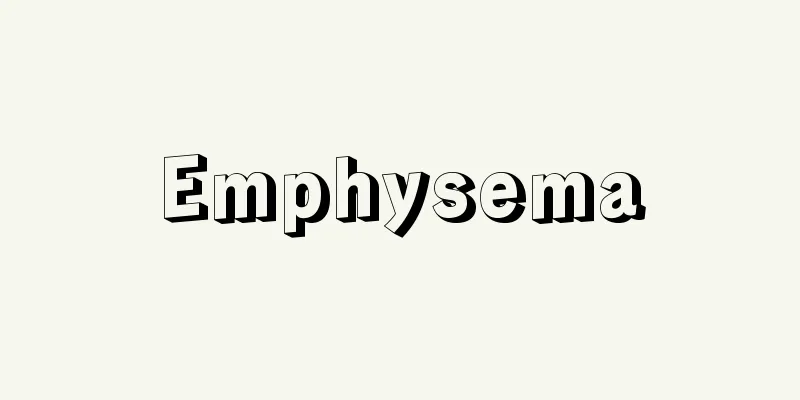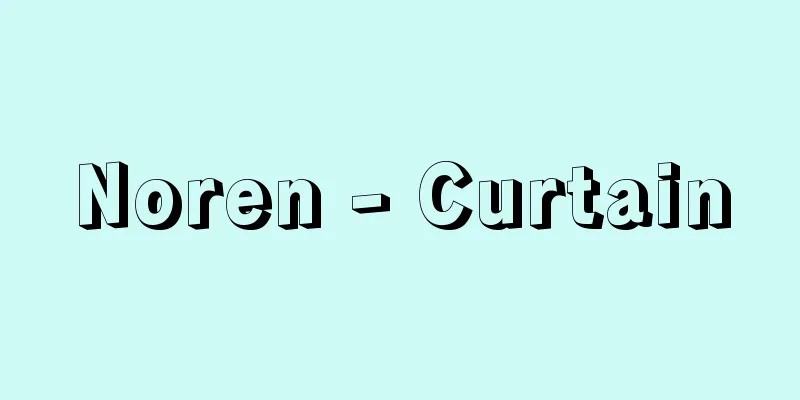Emphysema

|
What kind of disease is it? Main symptoms and course Emphysema is seen in relatively elderly people. The main symptom is shortness of breath when exercising, with little coughing or phlegm. The first symptom may be the inability to climb stairs, but as the condition progresses, even light exercise such as walking on flat ground or changing clothes can make breathing difficult. It is said that the cause is related to smoking and air pollution. In fact, more than 90 percent of emphysema patients are smokers, and 30 percent are heavy smokers, smoking more than 30 cigarettes a day. However, since only about 20% of heavy smokers develop emphysema, it is believed that only people who carry smoking-susceptibility genes (genes that react to tobacco smoke) develop the disease. ● Causes of the disease and how symptoms develop This is a disease caused by the destruction of alveolar tissue, which is the site of gas exchange in the lungs (exchange between carbon dioxide in the body and oxygen taken in through breathing), due to smoking, etc. When the number of normal alveoli decreases and the number of damaged alveoli increases, the elasticity of the lungs decreases and it becomes difficult for the lungs to contract when breathing out. Conversely, the bronchi become more easily collapsed, and as a result, it becomes more difficult to exhale air. Smoking often damages the bronchi, and the mucous membranes can swell and cause blockage of the bronchi. In this condition, breathing itself can be difficult. Furthermore, the oxygen concentration in the blood decreases due to insufficient gas exchange. Since the damaged tissue cannot be restored, treatment is performed to maintain the function and function of the remaining lungs. ●Characteristics of the disease It is more common in elderly men, with a male to female ratio of 3:1. EBM checks on common treatments and care [Treatment and care] Smoking cessation [Rating] ☆☆☆☆☆ [Evaluation Points] Highly reliable clinical studies have confirmed that quitting smoking is the most important step in the treatment of emphysema. Smoking not only makes breathing difficult, but also accelerates the progression of the disease. (1)(2) [Treatment and care] Drug therapy is performed using bronchodilators, adrenal corticosteroids, and expectorants. [Rating] ☆☆☆☆☆ [Evaluation points] The purpose of medicinal treatment is to widen the bronchi, suppress inflammation, and improve the clearance of phlegm. To achieve this, bronchodilators, corticosteroids, expectorants, etc. are inhaled or taken orally. The effectiveness of these treatments has been confirmed by highly reliable clinical studies. (3)-(5)(17)-(19)(20) [Treatment and care] Home oxygen therapy [Rating] ☆☆☆☆☆ [Evaluation points] For patients whose symptoms have progressed and whose shortness of breath and breathing difficulties have not been sufficiently alleviated by drug treatment alone, home oxygen therapy is performed. An oxygen delivery device is installed at home, and a portable oxygen tank is used when going out. The effectiveness of this type of treatment has been confirmed by highly reliable clinical studies. (6)-(8) [Treatment and care] Receive influenza vaccine in winter [Rating] ☆☆☆☆☆ [Evaluation points] Vaccination is recommended for patients with chronic bronchitis in Japan, Europe, and the United States. There are reliable clinical studies that show that vaccination reduces acute exacerbations and deaths by about 50 percent. (9)(10) Checking commonly used drugs with EBM Bronchodilator [Drug name] Spiriva (tiotropium bromide hydrate) (4) [Rating] ☆☆☆☆☆ [Drug name] Tersigan Aerosol (oxitropium bromide) (5) [Rating] ☆☆☆☆☆ [Drug name] Theodur/Unicon/Unifil LA (theophylline sustained-release formulation) (11)(12) [Rating] ☆☆☆☆☆ [Drug name] Berotec Aerosol (Fenoterol hydrobromide) (13)(14) [Rating] ☆☆☆☆ [Drug name] Atrovent Aerosol (Ipratropium bromide hydrate) (15) [Rating] ☆☆☆☆☆ [Drug name] Advair (salmeterol xinafoate/fluticasone propionate) (16) [Rating] ☆☆☆☆☆ [Drug name] Symbicort (budesonide-formoterol fumarate hydrate) (17) [Rating] ☆☆☆☆☆ [Evaluation points] The effectiveness of tiotropium bromide hydrate, oxitropium bromide and theophylline sustained-release tablets, fenoterol hydrobromide, and ipratropium bromide hydrate has been confirmed by reliable clinical studies. Long-acting beta- 2 agonist/inhaled corticosteroid combinations, such as salmeterol xinafoate/fluticasone propionate or budesonide/formoterol fumarate hydrate, have also been shown to be effective in highly reliable clinical studies. [Drug name] Hokunarin Tape (Tulobuterol) (18)(19) [Rating] ☆☆☆ [Evaluation points] Its effectiveness has been confirmed through clinical research. [Drug name] Salbutamol inhaler (salbutamol sulfate) (19) [Rating] ☆☆☆☆☆ [Evaluation points] Its effectiveness has been confirmed through highly reliable clinical studies. [Drug name] Meptin Air (Procaterol hydrochloride hydrate) [Rating] ☆☆ [Evaluation Points] Supported by expert opinion. [Medicinal use] Long-acting beta 2 agonist/inhaled steroid combination drug (3)-(5)(16)(17)(20) [Drug name] Advair (salmeterol xinafoate/fluticasone propionate) (16) [Rating] ☆☆☆☆☆ [Drug name] Symbicort (budesonide-formoterol fumarate hydrate) (17) [Rating] ☆☆☆☆☆ [Evaluation points] The effectiveness of each product has been confirmed through highly reliable clinical studies. Expectorant [drug name] Mucodyne (Carbocisteine) (22) [Rating] ☆☆☆☆☆ [Drug name] Mucosolvan (ambroxol hydrochloride) (23) [Rating] ☆☆☆☆☆ [Evaluation points] The effectiveness of each drug has been confirmed through highly reliable clinical studies. Overall, the most reliable treatment currently available <br /> First, quitting smoking is important As you can see from the fact that 90 percent of people who suffer from this disease are smokers, emphysema is a disease that is very closely related to smoking. Therefore, quitting smoking is the most important thing to do first. No matter what treatment you undergo, it will be almost ineffective as long as you continue to smoke. Even if you are not a smoker, it is not good to inhale the smoke of other people's cigarettes. In that sense, cooperation from family members is also necessary. Drug therapy is also effective. The use of bronchodilators to expand the bronchi, corticosteroids to suppress inflammation and prevent airway collapse, and expectorants to improve phlegm clearance are perfectly reasonable treatments. However, there are no drugs that can restore damaged tissue. Drug therapy is a treatment that allows patients to live their lives with as little pain as possible while effectively maintaining the structure and function of the remaining lungs. Home oxygen therapy for advanced cases Home oxygen therapy is effective for patients whose disease has progressed and whose symptoms such as shortness of breath and difficulty breathing are not sufficiently improved by drug treatment alone. By installing an oxygen delivery device at home, patients can receive a sufficient supply of oxygen and live at home without being hospitalized. Portable oxygen tanks allow you to go out Home oxygen therapy equipment also comes with portable oxygen tanks, so you can go out freely. There are also clinical studies that have shown that using portable oxygen tanks can improve quality of life (QOL) and extend life expectancy. (1)Anthonisen NR, Connett JE, Kiley JP, et al. Effects of smoking intervention and the use of an inhaled anticholinergic bronchodilator on the rate of decline of FEV1. The Lung Health Study. JAMA. 1994;272:1497-1505. Source: "EBM: A book that explains correct treatment" Information about the book "EBM: A book that explains correct treatment" |
|
どんな病気でしょうか? ●おもな症状と経過 肺気腫(はいきしゅ)は、比較的高齢の人にみられます。おもな症状は運動をすると息切れをおこすことで、せきや痰(たん)はほとんどでません。 最初の症状は階段を昇りきることができないなどですが、重症になると平らな場所の歩行、服を着替えるなどの軽い運動でも呼吸が苦しくなります。 原因は喫煙や大気汚染が関係しているといわれます。 実際に肺気腫の患者さんの90パーセント以上は喫煙者で、とくに30パーセントは1日30本以上のヘビースモーカーです。 ただし、ヘビースモーカーのうち肺気腫となるのは2割程度であるため、喫煙感受性遺伝子(たばこの煙に反応する遺伝子)を保有している人だけが発病するものと考えられています。 ●病気の原因や症状がおこってくるしくみ 肺におけるガス交換(体内の二酸化炭素と呼吸で取り入れた酸素の交換)の場である肺胞(はいほう)組織が、喫煙などにより破壊されたために生じる病気です。 正常な肺胞の数が減り、壊れた肺胞が増えると肺の弾力性が低下して、息を吐きだすときに肺が収縮しにくくなります。反対に気管支はつぶれやすくなり、結果として空気を吐きだしにくくなります。 喫煙で気管支も障害を受けていることが多く、粘膜の腫(は)れによる気管支の閉塞(へいそく)も生じます。こうした状態では呼吸をすること自体に困難を感じます。 さらにガス交換が十分できないために血液中の酸素濃度が低下します。壊された組織を元に戻すことはできないので、残された肺のしくみと働きを維持する治療が行われます。 ●病気の特徴 高齢の男性に多くみられ、男女比は3対1です。 よく行われている治療とケアをEBMでチェック [治療とケア]禁煙を行う [評価]☆☆☆☆☆ [評価のポイント] 肺気腫の治療において禁煙がもっとも重要であることが、非常に信頼性の高い臨床研究によって確認されています。たばこを吸うと呼吸が苦しくなるだけでなく、病気の進行を早めます。(1)(2) [治療とケア]気管支拡張薬、副腎皮質(ふくじんひしつ)ステロイド薬、去痰薬(きょたんやく)による薬物療法を行う [評価]☆☆☆☆☆ [評価のポイント] 薬による治療の目的は気管支を広げ、炎症を抑え、痰の切れをよくすることです。そのためには気管支拡張薬、副腎皮質ステロイド薬、去痰薬などを吸入したり服用したりします。こうした治療は非常に信頼性の高い臨床研究によって効果が確認されています。(3)~(5)(17)~(19)(20) [治療とケア]在宅酸素療法を行う [評価]☆☆☆☆☆ [評価のポイント] 症状が進行し、薬による治療だけでは息切れや呼吸困難が十分に改善しない患者さんに対しては、在宅酸素療法が行われます。酸素を送る器機を自宅に設置して、外出するときには携帯用の酸素ボンベを使用します。こうした治療は非常に信頼性の高い臨床研究によって効果が確認されています。(6)~(8) [治療とケア]冬期にはインフルエンザワクチンを接種する [評価]☆☆☆☆☆ [評価のポイント] 日本のほか欧米でも慢性気管支炎の患者さんに対するワクチン接種を勧めています。ワクチン接種によって、急性増悪や死亡が約50パーセント減少したという信頼性の高い臨床研究があります。(9)(10) よく使われている薬をEBMでチェック 気管支拡張薬 [薬名]スピリーバ(チオトロピウム臭化物水和物)(4) [評価]☆☆☆☆☆ [薬名]テルシガンエロゾル(オキシトロピウム臭化物)(5) [評価]☆☆☆☆☆ [薬名]テオドール/ユニコン/ユニフィルLA(テオフィリン徐放剤)(11)(12) [評価]☆☆☆☆☆ [薬名]ベロテックエロゾル(フェノテロール臭化水素酸塩)(13)(14) [評価]☆☆☆☆ [薬名]アトロベントエロゾル(イプラトロピウム臭化物水和物)(15) [評価]☆☆☆☆☆ [薬名]アドエア(サルメテロールキシナホ酸塩・フルチカゾンプロピオン酸エステル)(16) [評価]☆☆☆☆☆ [薬名]シムビコート(ブデソニド・ホルモテロールフマル酸塩水和物)(17) [評価]☆☆☆☆☆ [評価のポイント] チオトロピウム臭化物水和物、オキシトロピウム臭化物とテオフィリン徐放剤、フェノテロール臭化水素酸塩、イプラトロピウム臭化物水和物は、信頼性の高い臨床研究によって効果が確認されています。 サルメテロールキシナホ酸塩・フルチカゾンプロピオン酸エステルやブデソニド・ホルモテロールフマル酸塩水和物といった長時間作用性β2刺激薬/吸入ステロイド薬配合薬も、非常に信頼性の高い臨床研究によって効果が確認されています。 [薬名]ホクナリンテープ(ツロブテロール)(18)(19) [評価]☆☆☆ [評価のポイント] 臨床研究によって効果が確認されています。 [薬名]サルタノールインヘラー(サルブタモール硫酸塩)(19) [評価]☆☆☆☆☆ [評価のポイント] 非常に信頼性の高い臨床研究によって、効果が確認されています。 [薬名]メプチンエアー(プロカテロール塩酸塩水和物) [評価]☆☆ [評価のポイント] 専門家の意見では支持されています。 [薬用途]長時間作用性β2刺激薬/吸入ステロイド薬配合薬(3)~(5)(16)(17)(20) [薬名]アドエア(サルメテロールキシナホ酸塩・フルチカゾンプロピオン酸エステル)(16) [評価]☆☆☆☆☆ [薬名]シムビコート(ブデソニド・ホルモテロールフマル酸塩水和物)(17) [評価]☆☆☆☆☆ [評価のポイント] いずれも非常に信頼性の高い臨床研究によって効果が確認されています。 去痰薬 [薬名]ムコダイン(カルボシステイン)(22) [評価]☆☆☆☆☆ [薬名]ムコソルバン(アンブロキソール塩酸塩)(23) [評価]☆☆☆☆☆ [評価のポイント] いずれの薬も非常に信頼性の高い臨床研究によって効果が確認されています。 総合的に見て現在もっとも確かな治療法 まず禁煙が重要 この病気にかかる人の90パーセントが喫煙者であることからわかるように、肺気腫は喫煙との関係が非常に深い病気です。したがって、禁煙がまず第一に重要です。どのような治療をするにしても、喫煙を続ける限り、ほとんど効果は望めません。 また、本人が喫煙しなくても、他人の吸っているたばこの煙を吸い込むこともよくありません。その意味で家族の協力も必要になります。 薬物療法も有効 気管支を広げるための気管支拡張薬、炎症を抑えて気道の崩壊を防ぐための副腎皮質ステロイド薬、痰の切れをよくするための去痰薬などを使うことは、十分理にかなった治療法です。ただし、壊された組織を元に戻すことのできる薬物はありません。薬物療法は残された肺のしくみと働きをうまく維持しながら、苦痛をなるべく最小限に抑えて生活していくための治療となります。 進行した場合は在宅酸素療法 病気が進行し、薬による治療だけでは息切れや呼吸困難といった症状が十分に改善しない患者さんに対しては、在宅酸素療法が有効です。酸素を送る器機を自宅に設置することにより、十分な酸素の供給を受けながら、入院しないで自宅で生活することができるようになっています。 携帯ボンベで外出も可能 在宅酸素療法の器機には、携帯用の酸素ボンベも用意されており、自由に外出することもできます。携帯用の酸素ボンベを活用することで、生活の質(QOL)の向上や生存期間の延長を示した臨床研究もあります。 (1)Anthonisen NR, Connett JE, Kiley JP, et al. Effects of smoking intervention and the use of an inhaled anticholinergic bronchodilator on the rate of decline of FEV1. The Lung Health Study. JAMA. 1994;272:1497-1505. 出典 法研「EBM 正しい治療がわかる本」EBM 正しい治療がわかる本について 情報 |
>>: Pei Wěi (English spelling)
Recommend
Mount Yudono
A mountain located in the eastern part of Tsuruok...
Sugano Joyu
Name of the head of the Sugano school of Icchu-bus...
Regression - Regression
This refers to the movement of animals back to th...
Fukada [village] - Fukada
A village in Kuma County in southern Kumamoto Pref...
Stone pillars
〘Noun〙 A type of stone building. It consists of a ...
paix
… [Differences in views of peace between the cult...
Oiso Hills
Also known as the Yurugi Hills. A hill in the sout...
Stekel, W.
…Freud's theory was quickly accepted not only...
Mercury ointment - Suiginnankou
〘 noun 〙 A grayish-white ointment made by mixing m...
False positive rate
…Treatment must be started only after a histologi...
Urihime Goryo
...This is a folk tale with a girl born from a me...
Kurama Temple
Located in Kurama Honmachi, Sakyo Ward, Kyoto Cit...
Bull Terrier [species] (English spelling) Bullterrier
It is a domestic dog that originated in England. I...
Entering the priesthood - Nyūdō
〘Noun〙① (━suru) Buddhist term. (i) To enter a stat...
Kawagoe House
… [Arai Toshiro] [history] In the Middle Ages, it...









